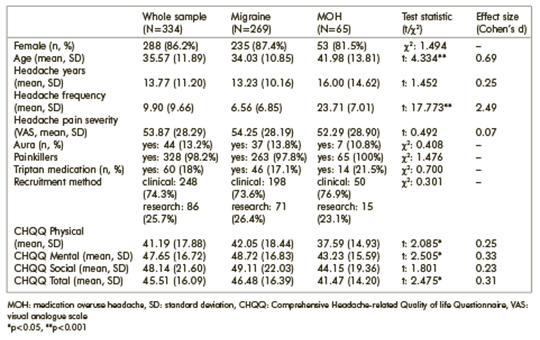Previous studies using generic and disease specific instruments showed that both migraine and medication overuse headache are associated with lower health-related quality of life (HRQoL). The aim of our study was to assess HRQoL differences in migraineurs and in patients with MOH and to examine how headache characteristics such as years with headache, aura symptoms, triptan use, headache pain severity and headache frequency are related to HRQoL. In this cross-sectional study 334 participants were examined (248 were recruited from a tertiary headache centre and 86 via advertisements). The Comprehensive Headache-related Quality of life Questionnaire (CHQQ) was used to measure the participants’ HRQoL. Data showed normal distribution, therefore beside Chi-squared test parametric tests (e.g. independent samples t-test) were used with a two-tailed p<0.05 threshold. Linear regression models were used to determine the independent effects of sex, age, recruitment method, headache type (migraine vs. MOH) and headache characteristics (presence of aura symptoms, years with headache, headache pain severity, headache frequency and triptan use) separately for each domain and for the total score of CHQQ. Significance threshold was adopted to p0.0125 (0.05/4) to correct for multiple testing and avoid Type I error. Independent samples t-tests showed that patients with MOH had significantly lower scores on all CHQQ domains than migraineurs, except on the social subscale. Results of a series of regression analyses showed that triptan use was inversely related to all the domains of HRQoL after correction for multiple testing (p<0.0125). In addition, headache pain severity was associated with lower physical (p=0.001) and total scores (p=0.002) on CHQQ subscales. Based on the results, different headache characteristics (but not the headache type, namely migraine or MOH) were associated with lower levels of HRQoL in patients with headache. Determining which factors play significant role in the deterioration of HRQoL is important to adequately manage different patient populations and to guide public health policies regarding health service utilization and health-care costs.





COMMENTS
0 comments